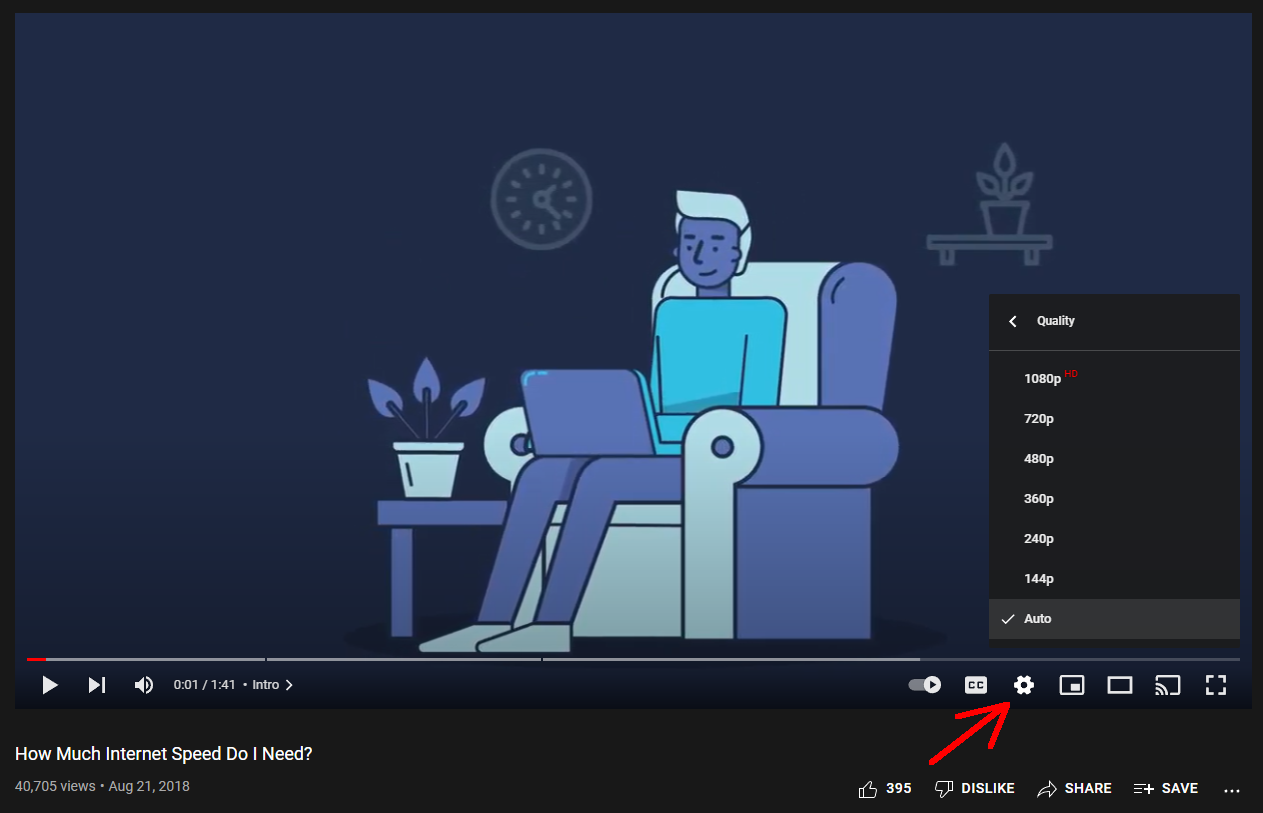How Much Internet Speed Do You Need for YouTube?
Nov 17, 2022 | Share
Internet Speed Guides, Streaming Guides
You can watch YouTube on very slow internet connections, even with download speeds below 1 Mbps. But it’s important to have a faster, more reliable connection for better video quality.
Higher definition content, like 4K or 1080p, requires between 2.5 Mbps and 20 Mbps, depending on the quality of the video.
Want to make sure that you have enough speed to watch YouTube on your phone?
Download our free, easy-to-use speed test app for quick and reliable results.
Want to make sure that you have enough speed to watch YouTube while doing all your normal online activities?
Take our test to find out how much internet speed you need.
What download speed do I need to watch YouTube?
YouTube has been around since 2005, and while it has kept up with the times by continually offering higher quality video for those with newer devices, it still also offers lower resolutions made for the days of dial-up internet.
| Video Resolution1 | Recommended sustained speed |
|---|---|
| 8K (4320p) | 100 Mbps* |
| 4K (2160p) | 20 Mbps |
| HD 1080p | 5 Mbps |
| HD 720p | 2.5 Mbps |
| SD 480p | 1.1 Mbps |
| SD 360p | 0.7 Mbps |
| SD 240p | < 0.5 Mbps* |
| SD 144p | < 0.5 Mbps* |
*Highspeedinternet.com recommendation.
The highest video quality available on YouTube is currently 8K, which is a fairly new addition and higher resolution than most videos on the site. As such, YouTube doesn’t have an official recommended speed yet, but we suggest having a connection with at least 100 Mbps download speed and unlimited data.
If you want to watch YouTube videos in 4K resolution, you’re going to need an internet connection that can sustain a speed of 20 Mbps. Although this means that you could get by on a 20 Mbps connection, you might experience pauses or drops in quality if your internet connection fluctuates at all or if other devices on your network are competing for that bandwidth. To get a smooth viewing experience, we recommend having a slightly higher speed than is required for the resolution you’re watching in order to let the video stream buffer.
Although faster internet connections are very helpful in watching online video, YouTube can deliver good quality, even on relatively slow connections. For example, you can watch HD video in 720p with a bandwidth of just 2.5 Mbps. Even slower DSL connections shouldn’t have a problem with that.
Pro tip:
The “p” that comes after resolutions like 1080p stands for progressive scanning, which means that every frame of video is a complete image. Older CRT televisions often used interlaced video (480i resolution), where each frame rendered only every other line of pixels. This halved the bandwidth required for a transmission and reduced the perception of flicker.
If you don’t have a fast connection, no worries. While YouTube offers resolution up to 4K, you can reduce the resolution of your videos all the way down to 144p. For reference, that’s smaller than the resolution of the original Nintendo.
YouTube doesn’t give specific speed recommendations for its lowest resolutions (they’re pretty low quality), but it lists 500 kbps as the minimum speed requirement for using the site.1 It also previously listed these lower resolutions as good options for people still on 56 kbps dial-up connections (though it admits that you might have to wait a bit for the video to load).2 That means no matter how slow your connection is, there’s probably a way to make YouTube videos work on your device.
How do I control my resolution?
By default, YouTube sets your resolution to Auto, which automatically uses the highest resolution that it can playback smoothly. The Auto setting will also change the resolution of the video on the fly if the speed of your connection fluctuates, so most of the time, you don’t have to do anything to get the highest quality video possible.
If you want to see a video in a specific resolution, or if you just don’t like your video quality going up and down, you can select the playback resolution by opening the video’s settings.

To open the video’s settings, click on the gear icon in the bottom right of the video. Then select Quality to see the available video resolutions. Just remember that if you select a resolution that requires a higher download speed than your internet connection can maintain, your video will have to pause to buffer anytime your bandwidth can’t keep up.
Download speed is fairly consistent across devices, which means that it doesn’t matter if you’re watching on a TV, a smartphone, or a computer—you still need the same speed to watch higher quality videos. If some of your devices are having trouble at higher resolutions and others aren’t, it might be a problem with the device or a problem with your Wi-Fi network.
What else do I need to watch YouTube?
Download speed is the most important requirement for watching YouTube videos, but there are also software and operating system requirements for using the site. If you’re watching YouTube on a mobile device or a smart TV, the easiest way to watch is to simply use the appropriate YouTube app on your device. You can also watch YouTube using a mobile browser, though the app usually works better.
Officially, the site supports the following browsers:
- Google Chrome
- Firefox
- Microsoft Edge
- Safari
- Opera
This will allow you to watch most content on the site; however, YouTube notes that some “premium” videos like movies, TV shows, and livestreams require faster connections and have additional requirements, such as specific operating systems:
- Windows 7 or higher
- Mac OS X 10.7 or higher
- Ubuntu 10 or higher
The Opera browser is also notably absent from the list of browsers required for premium content.
One other important note is that if you’re watching YouTube videos in a browser, 4K and 8K playback is unavailable unless you’re using Google Chrome. YouTube officially says that Chrome is required for watching all HD content in a browser, but we were able to watch 1080p in Firefox without any issues, so it seems that only 4K and 8K require Chrome. Both YouTube and the Chrome browser are owned by Google.
Pro tip:
Different video services have different speed requirements. For more information, check out our list of speed requirements for the top streaming services.
What upload speed do I need to make YouTube content?
If you’re a content creator, you have to worry about your upload speed in addition to your download speed. If you plan on livestreaming on YouTube, you probably want at least 20 Mbps upload speed.
Fortunately, you have a lot more flexibility if you’re not streaming live. The site has lots of handy tools for uploading, so while a faster upload speed will get your videos on YouTube faster, you can still be a YouTube creator with a slow upload speed.
If your uploads are taking too long, there are a few things you can do.3
- Reduce the file size of your video by using a different video format.
- Upload during off hours when there’s less internet traffic.
- Choose a lower resolution for your video.
- Upgrade your internet connection to get more upload speed.
If you want to upgrade your internet connection to get more upload speed, the easiest way is to choose an internet connection that has symmetrical upload and download speeds, like fiber.
Need a better connection to launch your YouTube career? Check out other providers in your area.
Sources
- YouTube, “System Requirements,” Accessed November 4, 2021.
- YouTube, “Watch Videos on Slow Connections,” Archived copy from March 19, 2015. Accessed November 16, 2021.
- YouTube, “Video Stuck During Upload,” Accessed November 16, 2021.
Author - Peter Christiansen
Peter Christiansen writes about satellite internet, rural connectivity, livestreaming, and parental controls for HighSpeedInternet.com. Peter holds a PhD in communication from the University of Utah and has been working in tech for over 15 years as a computer programmer, game developer, filmmaker, and writer. His writing has been praised by outlets like Wired, Digital Humanities Now, and the New Statesman.
Editor - Rebecca Lee Armstrong
Rebecca Lee Armstrong has more than six years of experience writing about tech and the internet, with a specialty in hands-on testing. She started writing tech product and service reviews while finishing her BFA in creative writing at the University of Evansville and has found her niche writing about home networking, routers, and internet access at HighSpeedInternet.com. Her work has also been featured on Top Ten Reviews, MacSources, Windows Central, Android Central, Best Company, TechnoFAQ, and iMore.







